Archive for October 26th, 2012
Port denies FOI abuse
(CNS): The Port Authority of the Cayman Islands denied that it had breached either “the spirit or the letter of the FOI Law” in the wake of a damning ruling from the information commissioner, who condemned the authority for the way it had handled a freedom of information request about the GLF proposals to build the cruise berthing facilities in George Town. In a media statement released Friday evening following Jennifer Dilbert’s extremely critical findings regarding a hearing requested by CNS, the port refused to accept that it had done anything wrong, stating that it was “surprised and disappointed by the tone” of the commissioner’s decision.
“The Port Authority does not believe that the critical comments are in any way justified, nor are they relevant to the legal issues that were the subject of the ICO's ruling,” the port stated in its release following the decision published by CNS on Thursday.
“It is denied that the Port Authority has breached either the spirit or the letter of the FOI Law, and any suggestions to that effect are strongly rejected. However, as the matter is still within the period for any appeal, the Port Authority does not believe that it is appropriate at this stage to debate the issues in the media,” the authority said after releasing the media statement.
However, CNS takes a different position and agrees with Dilbert’s ruling. Wendy Ledger, the CNS reporter who made the request, said, "Given the circumstances, it was an extremely restrained opinion from the commissioner and a credit to her professionalism.”
When CNS asked for the release of documents from the port that had already been ruled on by Dilbert in a previous decision, the authority refused on the grounds that CNS was a different applicant, despite already knowing that the documents were not exempt under the law.
For no reason other than the authority’s recalcitrance, CNS was forced to wait for the full thirty days, and when the documents were released it was clear that there were many more. Given the already protracted issues relating to the request, CNS handed the case over to the ICO, which then faced endless delays and difficulties from the authority.
Despite the obstructionism and time wasting by the authority, the ICO were eventually able to see all of the documents and Jan Liebaers, the deputy commissioner, spent many days ploughing through reams of documentation examining what was exempt, what was irrelevant and what should be released — a job which should have been undertaken by the port authority information manager.
“It was without doubt one of the most protracted FOI cases CNS has had to deal with,” said Ledger. "From the very outset, when it refused to release the original documents to CNS because we were a ‘different applicant’, the port set the tone for how this request progressed. We don’t do FOI requests at CNS for the good of our health or because we are bored, we do them because they are issues of public interest," she noted.
“Many people are still afraid to make request for a number of what are probably unfounded reasons and there is an expectation that the media will do this on the public’s behalf. After all, the Caymanian public will be the ones in the end who are footing what will be an enormous bill for the cruise facilities,” Ledger added.
In its statement on Friday the port clung to the issue of legal privilege over why it refused to release records, stating that it would consider its position regarding the documents which Dilbert said should be released.
See full port statement below.
Related article:
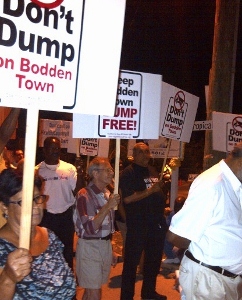
MLAs silent on dump debate
 (CNS): The two government representatives for Bodden Town have remained silent in the face of an invitation by district activists to engage in a debate over the relocation of the landfill to their constituency. Neither minister Mark Scotland or back-bencher Dwayne Seymour have responded to the invititation sent to both men on Monday, which followed the challenge issued by former district MLA Charles Clifford to publicly discuss the issue with him and Gregg Anderson, a coalition leader in the Bodden Town Civic Centre. Scotland reportedly agreed to the debate after he called into the radio morning talk show on Rooster last week when Clifford was a guest, telling the host he accepted the challenge .
(CNS): The two government representatives for Bodden Town have remained silent in the face of an invitation by district activists to engage in a debate over the relocation of the landfill to their constituency. Neither minister Mark Scotland or back-bencher Dwayne Seymour have responded to the invititation sent to both men on Monday, which followed the challenge issued by former district MLA Charles Clifford to publicly discuss the issue with him and Gregg Anderson, a coalition leader in the Bodden Town Civic Centre. Scotland reportedly agreed to the debate after he called into the radio morning talk show on Rooster last week when Clifford was a guest, telling the host he accepted the challenge .
However, the coalition now believes the environment minister and his UDP colleague are backing out. Coalition members said Friday that they have not even received an acknowledgment from either of the men following the email sent out setting out the proposed parameters for the debate and allowing the district MLAs to choose a convenient date before 10 November.
Charles Clifford said that there was “not even the courtesy of a reply to our private letter following up on his agreement to a public debate.”
The former environment minister and MLA for the district, who lost his seat to Seymour by a thin margin in the 2009 election, said he did not believe either man would have been elected had they campaigned on a platform that included moving the landfill to Bodden.
“Had Minister Scotland and Mr Seymour promised the people of Bodden Town a garbage dump when they were campaigning in 2009, they would not have been elected,” Clifford said as he accused the two representatives of breaking promises to their constituents and refusing to address their continued request for answers on the dump issue. “They know what they are doing is wrong and against the wishes of their constituents and that is why they are running and hiding.”
Although Clifford has resigned from the opposition PPM since he lost his Bodden Town seat, it is understood that he has not retied from politics and is likely to run in the May 2013 elections in the district where he is strongly tipped to be returned. After completing his articles earlier this year with judicial services, Clifford was called to the bar recently and has since stepped back into the public limelight. He has lent his public support to the coalition in its vociferous opposition to the idea of moving the George Town landfill to a new pristine site for the benefit of one developer rather than tackling the problem in situ for the benefit of all.
Clifford and coalition leader Vincent Frederick were guests of Cayman Crosstalk on 15 October when Scotland called in about the proposal to move the landfill. Clifford challenged Scotland to a public debate on the issue and Austin Harris said at the end of the show that Scotland had informed him he would accept the challenge.
On 22 October coalition chairman Alain Beiner followed up and sent a letter via email to Scotland and Seymour outlining a proposed formatfor the debate and asking for a reply within 48 hours.
The coalition members said they had received an automated receipt confirmation from Seymour’s Blackberry so they were confident the men have the correspondence but despite asking Scotland to respond within two days by Friday, the two MLAs remained silent.
“A public debate is the best forum for both sides – the two government MLAs for Bodden Town who support the proposed dump and the Coalition which opposes it – to openly and fairly present their arguments to the people of Bodden Town and of the entire island,” Beiner said. “How else can ordinary people fully understand the issue? How else can Government’s ‘public consultation of a technical nature’, apparently promised for November, be in the least bit meaningful, and relevant to the real-life concerns of our district?”
He said the coalition considers a public debate an essential part of the process and regrets the lack of any responsefrom the Bodden Town MLAs for Bodden Town. “They continue to hide from the people who elected them. Was Minister Scotland’s radio-show agreement to a debate just another lie?” Beiner asked.
See email to Scotland and Seymour below.

Local business donates ‘junk’ to Red Cross
 (CNS): A local company that charges people and business to collect their over-sized rubbish and dispose of it is donating some of that junk to the Red Cross the local charity ash revealed. Not all of the discarded stuff collected by the trash experts is necessarily rubbish some the firm said is in very good condition and as a result they are taking the items to the charity store rather than adding to the growing Mount Trashmore at the George Town landfill. “We are always in need of good quality items to meet the growing needs of our client base,” said the Thrift Shop Manager, Remy Imperial who offered her thanks to the local company.
(CNS): A local company that charges people and business to collect their over-sized rubbish and dispose of it is donating some of that junk to the Red Cross the local charity ash revealed. Not all of the discarded stuff collected by the trash experts is necessarily rubbish some the firm said is in very good condition and as a result they are taking the items to the charity store rather than adding to the growing Mount Trashmore at the George Town landfill. “We are always in need of good quality items to meet the growing needs of our client base,” said the Thrift Shop Manager, Remy Imperial who offered her thanks to the local company.
“We are very grateful that JUNK Removal & Recycling have been so proactive in partnering with us,” she added.
“We decided to team up with the CI Red Cross as we constantly found that a good deal of items from the removal jobs we did were still in very good condition,” explained JUNK owner/manager Mark Conolly. “We figured we would help recycle by passing these items, such as furniture, appliances, and others, to the Thrift Shop rather than throwing it away and adding to the landfill,” he said.
The Cayman Islands Red Cross Thrift Shop serves not only as a store but also as a community programme where vulnerable persons who are assessed by the Red Cross or referred by partnering agencies are given access to the goods free of charge to them.
“Along with dropping the items off to us, Mr. Conolly also gets in touch with us so that we can also do pick up of donations,” Imperial said. “We are always encouraging the public to use our donation pick up service, which is free of cost to the donor,” she adds.
The CI Red Cross Thrift Shop is open Tuesday-Friday, 9am-2pm & 5pm-7pm, and on Saturday, 7:30am-1:30pm. Donations are accepted any time the Red Cross is open. For more information, contact the Thrift Shop Manager on shop@redcross.org.ky or 949-6785ext. 31.
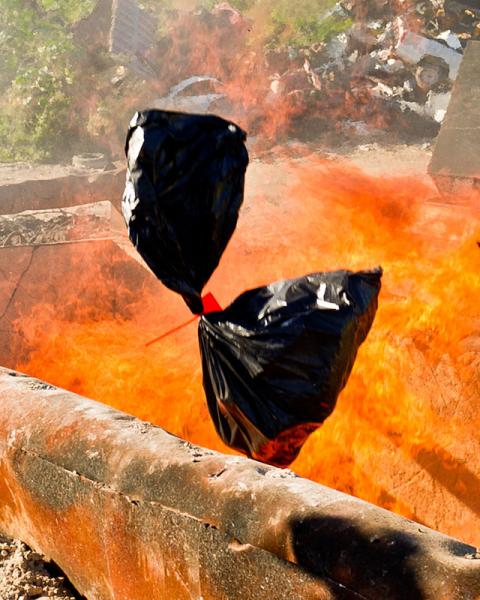
RCIPS sets fire to drugs and fake handbags
 (CNS): It took four pick-up trucks to transport more the more than 830lbs of drugs as well as a collection of counterfeit goods to the George Town dump this morning where the RCIPS set fire to it all. The burning included a collection of evidence seized by police and used in criminal cases that have now been dealt with. The police burned a total of 813lbs of ganja and some 20lbs of cocaine which was take of the streets of Cayman as well as a collection of fake designer bags, wallets and other accessories which alone filled up one of the pick-up trucks used to transport the goods to the landfill. (Photo by Dennie Warren Jr)
(CNS): It took four pick-up trucks to transport more the more than 830lbs of drugs as well as a collection of counterfeit goods to the George Town dump this morning where the RCIPS set fire to it all. The burning included a collection of evidence seized by police and used in criminal cases that have now been dealt with. The police burned a total of 813lbs of ganja and some 20lbs of cocaine which was take of the streets of Cayman as well as a collection of fake designer bags, wallets and other accessories which alone filled up one of the pick-up trucks used to transport the goods to the landfill. (Photo by Dennie Warren Jr)
A police spokesperson said that drug burns are not unusual and are carried out when there is an operational need and on the agreement of the courts when the drugs are no longer required for evidence.
“The seizures of the drugs were mainly as a result as a result of proactive policing operations throughout the jurisdiction and shows that we are making a real dent in the importation and availability of drugs on the islands,” she added.

Cayman and the 2012 apocalypse
The good news is that nobody will have to worry about conditions at the Turtle Farm. The high cost of living won’t be a burden anymore either. The bad news is that the Cayman Islands will be swept under the sea, everyone will die, and all of civilization will crumble in a fiery spasm of unprecedented chaos and destruction.
Here we go again. We are fast approaching yet another angry apocalypse and no one should be surprised. Throughout history, and probably deep into prehistory, a good number of us have always been obsessed with the end of the world and been willing to jump onboard whenever someone comes along with a firm date for doomsday. This time it’s the Maya 2012 prophecy. According to believers, the Maya calendar ends on December 21, 2012 so the world will too.
Poll results vary but about ten to 12 percent of American adults think the world is going to end this year. In China, 20 percent think it’s lights out on December 21. About 13 percent in Turkey, Russia, Mexico, and Japan believe it. Overall, one in ten people globally think the Maya doomsday prediction will come true. And don’t think that it’s all a big joke. NASA astronomer David Morrison says some people are so concerned about it that they are considering suicide.
Based on my encounters, with astrology fans in George Town, obeah practitioners in West Bay and rapture-ready folks in East End, I’m guessing that a significant percentage of people in the Cayman Islands are eyeing December 21 with concern. If you are one of these people, read on and allow me to ease your mind. If you know someone who thinks there is something to this Maya prophecy, please forward this commentary to them. Do it quickly. No one should suffer this much nonsense rattling around inside their skull.
What is going on? Why do hundreds of millions of people believe this extraordinary unproven claim? First of all, the Maya civilization existed from about 200 to 900 CE. They were in southern Mexico, Guatemala, Belize, El Salvador, and parts of Honduras—very near the Cayman Islands. Maya still live in Central America today and very few of them pay any attention to this doomsday date, which is our first hint that something is very wrong.
So here is the key question: How did the Maya know centuries ago that the world would end on December 21, 2012? How did they figure out something today’s scientists couldn’t? Answer: They didn’t! They never made this prediction! It is the invention of very strange modern people. The Maya may have tracked the path of the Moon, built impressive pyramids, and ripped beating hearts out of people in the name of religion, but they never claimed to know when the world would end. Imagine that, millions of people believe in a Maya prediction that not only has no evidence to support it but was never made by the Maya in the first place.
The Maya had several calendars, one of which lasts 5,125 years. This “long-count calendar” ends this year. This is the basis of the idea that the world will end. It’s like a Maya expiration date for everything. But here’s the key: the end of a calendar does not mean the world ends too. If it did, our 12-month calendar would mark Earth’s destruction every December 31. But it doesn’t. When the calendar stuck on your refrigerator door reaches December 31 it doesn’t trigger earthquakes, plagues, and asteroid strikes. You just throw it away and buy a new one. Same with the Maya long-count calendar. This is not some wild hunch I am extracting from my nether regions. This is the conclusion of every credible Maya scholar. There are no artifacts discovered to date that show the Maya expected the world to end when their long-count calendar ended. In fact, inscriptions have been found that clearly show the Maya expected the world to be here after 2012 because they wrote about important events occurring after that date.
Another fatal problem with this prediction that the Maya never predicted is that it’s based on a bad date to begin with. It would be wrong even if it was right. The first long-count calendar begins on a creation date of 3,114 BCE. We know beyond any doubt that the world and/or humankind are much older than five thousand years. Therefore any predictions about future events that are calculated using this or any similar creation date are going to be wrong. It’s a mistake based on a mistake. This is why Rev. Harold Camping’s much-publicized rapture date in 2011 was so obviously silly. He based his calculations on the Earth being less than 10,000 years old. Anytime someone attempts to solve a mathematical problem and gets the first number in the equation wrong by more than four billion years errors are unavoidable.
The greater question in all of this is why so many of us keep falling for these hollow predictions. My hunch is that they are so tempting because we subconsciously fear a lonely death. Maybe this is what makes the idea of a global doomsday so irresistible. We are social creatures, after all. We need one another more than we realize. Is it any surprise, then, that many of us might feel the urge to all go down together? For many, a collective death is more appealing than dying alone in a car on the side of a road after a traffic accident or quietly expiring in some hospital bed.
It is important to understand that irrational beliefs about doomsday have little to do with intelligence or education. One can be very bright, but if she or he is a weak skeptic then bad ideas can easily creep in and take root. For example, no less than Isaac Newton, perhaps the greatest scientist of all time, was quite certain that the end of the world will occur in 2060. But that’s not going to happen either because, for one reason, he based his calculations on an incorrect creation date for the Earth. Bad input gets you every time. When it comes to irrational beliefs, anyone who is a human being with a human brain is vulnerable to stumbling. The best we can do is stay humble and stay skeptical.
I can tell you right now what will happen on December 22, the morning after the Maya doomsday. Because of hindsight bias, many 2012 believers will sincerely imagine that they knew it was nonsense all along. Some will say the numbers were a bit off and come up with a new date for the end. Others will say that it did happen but it was an invisible doomsday or a doomsday of the spirit—something that can’t be detected or disproved, of course. And then, before long, another irrational doomsday belief will come along and millions of innocent brains will once again be under assault.
This colossal waste of time and nervous energy doesn’t have to keep happening. People only have to commit themselves to being good skeptics. Do that and watch the bogus beliefs and crazy claims just melt away. It’s not so difficult. Demand evidence for weird ideas. Ask questions. Consider the source. Listen to contrary opinions. Learn how easily confirmation bias and other natural quirks of the mind betray us to make silly things that aren’t true seem reasonable. In short, think before you believe.
Guy P. Harrison is the author of three science-themed books: “50 Popular Beliefs That People Think are True”, “Race and Reality: What Everyone Should Know About Our Biological Diversity”, and “50 Reasons People Give for Believing in a God”. His next book is scheduled for publication in March, 2013.

Insurance duty change is property tax, says Miller
 (CNS): The independent member for North Side has accused government of introducing a property tax via the back door with changes to the stamp duty law, which introduces a 2% rate on insurance policies rather than the previous flat rate fee of $12. One of a number of tax increases introduced by government in the 2012/13 budget in order to meet the strict spending parameters set out by the FCO government, the amendment is expected to be brought to the Legislative Assembly at next month’s meeting. As well as increasing stamp duty, the amendment provides for duty on property insurance.
(CNS): The independent member for North Side has accused government of introducing a property tax via the back door with changes to the stamp duty law, which introduces a 2% rate on insurance policies rather than the previous flat rate fee of $12. One of a number of tax increases introduced by government in the 2012/13 budget in order to meet the strict spending parameters set out by the FCO government, the amendment is expected to be brought to the Legislative Assembly at next month’s meeting. As well as increasing stamp duty, the amendment provides for duty on property insurance.
Ezzard Miller said that this equates to an annual property tax as it is based on the value of the insurance policy, which is in turn based on the value of people’s homes. The switch means a massive increase, not just for the wealthy but all homeowners, even those owning modest homes. He said the jump from the annual flat fee of $12 to a 2% rate was not just a massive hike but a tax on property ownership. The independent member said most homeowners will not have a choice in the matter asmost have a mortgage and must have property insurance.
“In the current economic climate this is going to affect many ordinary people,” he said. “This is nothing more than a property tax via the back door.”
Miller said he hoped to see people showing their objection to the tax on insurance policies because the man in the street was being crippled by the fees and taxes imposed by the current government due to its failure to address public spending while giving away duty waivers to businesses.
As result, when the amendment comes before the LA he would not support the bill , he said, but noted that his one vote would do little to alter government’s mind; that would take greater support from the community, he said, and pointed to the success of the Cayman United Group in its opposition to the propose ex-pat tax, which was dropped because of the public outcry. “I would like to see the same kind of opposition to this tax from the local activists,” he said.
The new law will also see stamp duty increased from 4% for Caymanians and 6% for non-Caymanians to 7.5% (the current rate for Seven Mile Beach) regardless of the location. However, the threshold before duty is payable for locals has been increased to properties of $300,000 and over and Caymanians will still only pay 2% on those up to $400,000.
Ex-cop released on bail in face of appeal
(CNS): Following the filing of an appeal by his attorney against the sentence passed by Justice Alex Henderson last Friday, Rabe Welcome has been released from HMP Northward pending the outcome of that appeal. Welcome was convicted by a jury in June this year of wounding after breaking a man’s arm during an early morning arrest while off-duty. Found to have crossed the line of reasonable force when he beat the victim who had committed an arrestable offence, the former police officer was sentenced to six months. Having served less than one week, however, Welcome was released Thursday following an application to the court. (Image courtesy of Cayman 27)
The incident took place almost three and a half years ago and Welcome was suspended from duty until the trial; following his conviction Welcome was sacked. Although this was Welcome’s first offence and there was no other evidence of any disciplinary action against the former cop and one time customs officer, the judge jailed Welcome as he said it was important to send a message that the use of excessive force by a law enforcement officer would not be tolerated.
Related article:

Baptist hospital promotes new heart valve treatment
 (CNS): One of the US based hospital that provides care for patients from the Cayman Islands is offering treatment for those with damaged aortic heart valves replaced without traditional surgery with a new FDA-approved procedure. The Baptist Cardiac & Vascular Institute at Baptist Hospital of Miami said that transcatheter aortic valve replacement (TAVR) is a promising treatment in which ‘a team of highly skilled doctors use a minimally invasive approach, gaining access to the heart through a small catheter inserted in the skin, to replace the diseased aortic heart valve while the heart is still beating” which the hospital claims eliminates the need for the heart-lung machine.
(CNS): One of the US based hospital that provides care for patients from the Cayman Islands is offering treatment for those with damaged aortic heart valves replaced without traditional surgery with a new FDA-approved procedure. The Baptist Cardiac & Vascular Institute at Baptist Hospital of Miami said that transcatheter aortic valve replacement (TAVR) is a promising treatment in which ‘a team of highly skilled doctors use a minimally invasive approach, gaining access to the heart through a small catheter inserted in the skin, to replace the diseased aortic heart valve while the heart is still beating” which the hospital claims eliminates the need for the heart-lung machine.
“This is a valuable option for inoperable patients with severe aortic stenosis to improve their quality of life,” said Ramon Quesada, M.D., the Institute’s medical director of interventional cardiology and cardiac research in a release about the new medical service.
Dr. Quesada and Jonathan Roberts, M.D., both interventional cardiologists, Niberto Moreno, M.D., heart surgeon and chief of Baptist Health’s cardiothoracic surgery, Lisardo Garcia-Covarrubias, M.D., cardiothoracic surgeon, and Ralph Machado, M.D., cardiac anesthesiologist comprise the multi-disciplinary team of doctors who perform the procedure.
“Studies show that patients who received the artificial heart valve lived longer, had better heart function and felt better than those patients who did not receive a new valve but were treated medically,” Dr. Moreno said.
During a TAVR, the patient is given general anesthesia while doctors insert a catheter into the femoral artery in the groin and guide it to the heart,” the release stated. An artificial heart valve made of a steel frame and animal tissue is fed into the catheter and threaded to the heart to replace the damaged aortic valve during the two-hour procedure. The frame of the new Edwards SAPIEN transcatheter valve is strong and uses part of the diseased valve to anchor securely in place.
Artic stenosis primarily affects older people with men having higher rates than women, and heart disease is associated with a 50 percent increase in the risk for death from heart attack.
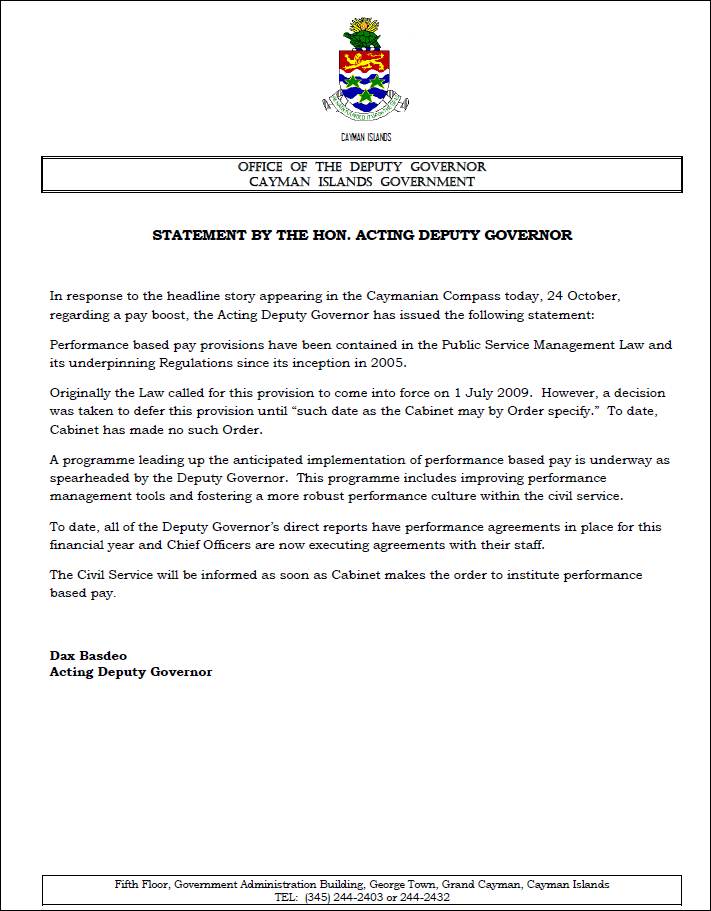
No money for performance based pay in CS
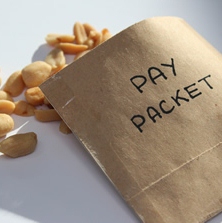 (CNS): No matter how well civil servants do in fulfilling their roles there will not be any bonus payments because government does not have the money. Although civil services heads have been working for some time to set the targets that will form the basis of performance pay in future as provided for in the public service management law (PSML), there is no sign of its implementation any time soon as there is no money in government coffers to boost any public servants’ pay packets. In a memo circulated by Acting Deputy Governor Dax Basdeo yesterday, civil servants were told that until the Cabinet approved the performance related pay system, there would be no bonuses.
(CNS): No matter how well civil servants do in fulfilling their roles there will not be any bonus payments because government does not have the money. Although civil services heads have been working for some time to set the targets that will form the basis of performance pay in future as provided for in the public service management law (PSML), there is no sign of its implementation any time soon as there is no money in government coffers to boost any public servants’ pay packets. In a memo circulated by Acting Deputy Governor Dax Basdeo yesterday, civil servants were told that until the Cabinet approved the performance related pay system, there would be no bonuses.
The PSML provides for civil servants to be paid based on the things they achieve in their day to day roles based on specific targets. Depending on how well they do, public servants will, once the system is in place, be able to earn themselves extra cash. Those that do not perform will not lose money but would be closely monitored and they could be dismissed if their targets are consistently missed.
However, even though the law had called for this performance based pay system to come into effect in 2009, Cabinet has not yet issued the necessary order and so the system is not yet in place.
Nevertheless, the deputy governor has overseen a programme to develop a system in preparation for the eventual implementation of the performance pay structure and to foster a “more robust performance culture within the civil service”, Basdeo said in the memo.
Performance agreements have been drawn up and the acting deputy governor said that chief officers were working with staff to execute them. However, they will not impact salaries until such a time as Cabinet makes the order.
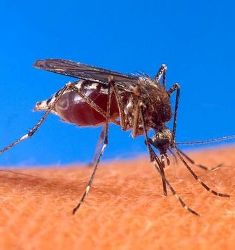
Mosquito attack continues in face of fifth local case
 (CNS): After a fifth case of locally transmitted dengue fever in West Bay, the MRCU is pressing ahead with its additional ground and air operations despite the weather. In an effort to keep the numbers of the Aedes aegypti, the mosquito that carries the disease, under control, the unit will be carrying out early evening aerial missions on Mondays, Wednesdays and Fridays, instead of Tuesdays and Thursdays as originally scheduled. However, the mozzie experts are asking people to follow the guidelines to eliminate breeding grounds around their homes and to prevent bites. In the most recent outbreak of the disease, of the eight cases that have been confirmed three were imported and five transmitted in Cayman.
(CNS): After a fifth case of locally transmitted dengue fever in West Bay, the MRCU is pressing ahead with its additional ground and air operations despite the weather. In an effort to keep the numbers of the Aedes aegypti, the mosquito that carries the disease, under control, the unit will be carrying out early evening aerial missions on Mondays, Wednesdays and Fridays, instead of Tuesdays and Thursdays as originally scheduled. However, the mozzie experts are asking people to follow the guidelines to eliminate breeding grounds around their homes and to prevent bites. In the most recent outbreak of the disease, of the eight cases that have been confirmed three were imported and five transmitted in Cayman.
The department said thisweek that it is waiting on results for a further 20 cases and officials say there may be further local cases confirmed as a result of the recent rain and the increase in standing water where the Aedes aegypti breeds.
Although dengue can be severe, even fatal, none of the local patients have been critically ill and most have now recovered. Dengue fever is not passed from person to person. For transmission to occur the Aedes mosquito must bite the sick patient in the first week of symptoms, after which he becomes non-infectious, and then must survive for a further 8-10 days in order to transmit the disease. Those insects destroyed during this period are unable to pass on the disease.
The public are advised that the insecticides which MRCU uses are safe and approved by the Environmental Protection Agency (EPA) in the United States.
Aedes aegypti lives and breeds in and around houses. To avoid their homes becoming breeding grounds, members of the public should drain water from coolers, tanks, barrels, drums and buckets, remove objects in the yard which have collected water and keep water containers covered.
While most mosquitoes bite at dawn or dusk, this mosquito also bites in the day so the Public Health Department advises people to wear long sleeves, long trousers and mosquito repellent as a precaution against bites.
Any questions or queries should be directed to MRCU on 949-2557 or info@mrcu.ky.